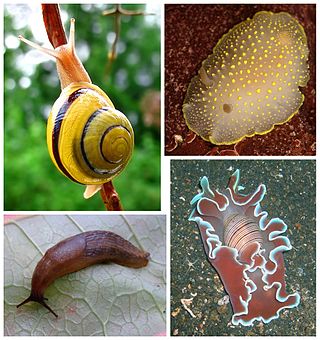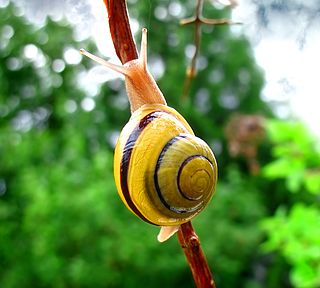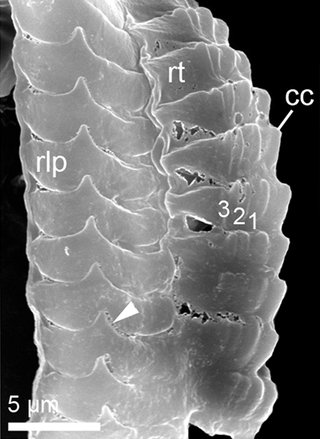
The order Aplysiida, commonly known as sea hares, are medium-sized to very large opisthobranch gastropod molluscs with a soft internal shell made of protein. These are marine gastropod molluscs in the superfamilies Aplysioidea and Akeroidea.

Sea slug is a common name for some marine invertebrates with varying levels of resemblance to terrestrial slugs. Most creatures known as sea slugs are gastropods, i.e. they are sea snails that, over evolutionary time, have either entirely lost their shells or have seemingly lost their shells due to having a significantly reduced or internal shell. The name "sea slug" is often applied to nudibranchs and a paraphyletic set of other marine gastropods without apparent shells.

Opisthobranchs is a now informal name for a large and diverse group of specialized complex gastropods which used to be united in the subclass Opisthobranchia. That taxon is no longer considered to represent a monophyletic grouping.

Heterobranchia, the heterobranchs, is a taxonomic clade of snails and slugs, which includes marine, aquatic, and terrestrial gastropod molluscs.

Euthyneura is a taxonomic infraclass of snails and slugs, which includes species exclusively from marine, aquatic and terrestrial gastropod mollusks in the clade Heterobranchia.

Acochlidiacea, common name acochlidians, are a taxonomic clade of very unusual sea snails and sea and freshwater slugs, aquatic gastropod mollusks within the large clade Heterobranchia. Acochlidia is a variant spelling.

Parhedylidae are a taxonomic family of sea slugs, marine gastropod mollusks in the superfamily Parhedyloidea.
Strubellia paradoxa is a species of freshwater slug, a shell-less freshwater gastropod, an aquatic gastropod mollusk within the clade Acochlidiacea.

Freshwater snails are gastropod mollusks that live in fresh water. There are many different families. They are found throughout the world in various habitats, ranging from ephemeral pools to the largest lakes, and from small seeps and springs to major rivers. The great majority of freshwater gastropods have a shell, with very few exceptions. Some groups of snails that live in freshwater respire using gills, whereas other groups need to reach the surface to breathe air. In addition, some are amphibious and have both gills and a lung. Most feed on algae, but many are detritivores and some are filter feeders.
Pseudunela espiritusanta is a species of sea slug, an acochlidian, a shell-less marine gastropod mollusk in the family Pseudunelidae.

Acochlidium fijiiensis is a species of freshwater gastropod, an aquatic gastropod mollusc within the family Acochlidiidae. Acochlidium fijiiensis has no shell.

Pseudunela is a genus of minute sea slugs, acochlidians, shell-less marine or temporary brackish or brackish gastropod mollusks in the clade Acochlidiacea.
Aiteng ater is a species of sea slug, a marine gastropod mollusc in the family Aitengidae. The specific name ater is from the Latin language and means black, in reference to the appearance of the slug on the mud.
Aiteng is a genus comprising three species of sea slug, A. ater and A. mysticus being found in intertidal zones while A. marefugitus is fully terrestrial. Aiteng is the only genus in the family Aitengidae. The generic name Aiteng is derived from the name of a black puppet Ai Theng, which is one of the shadow play puppets in southern Thailand.

Panpulmonata is a taxonomic clade of snails and slugs in the clade Heterobranchia within the clade Euthyneura.
Aiteng mysticus is a species of sea slug in the family Aitengidae, found around Hisamatsu, Miyako-jima, Okinawa, Japan. Morphologically it clearly belongs to the Aitengidae, but it shows differences to Aiteng ater at genus or species level. Its affinity to Aiteng ater is confirmed by comparison of the mitochondrial 16S rRNA sequences.

Pontohedyle milaschewitchii is a species of sea slug, an acochlidian, a shell-less marine gastropod mollusk in the family Parhedylidae.

Pontohedyle is a genus of sea slugs, acochlidians, shell-less marine gastropod mollusks in the family Parhedylidae. Sea slugs in this genus are highly simplified and uniform.

Bathyhedyle boucheti is a species of panpulmonate slug, a deep-sea dwelling gastropod native to the continental slope off the coast of Mozambique. It is the first ever such panpulmonate slug to be discovered at such depths. It is the only known member of its family group. Its radular formula is 1.1.2.
Pneumopulmonata is a superorder of heterobranch pulmonate gastropods belonging to the subterclass Tectipleura. It was defined based on results of phylogenomic studies and named by Krug et al. (2022). The superorder unites all of Panpulmonata except for Sacoglossa.











